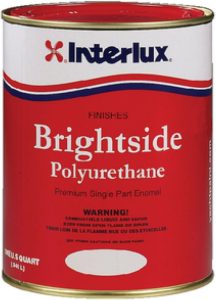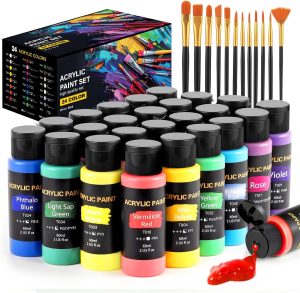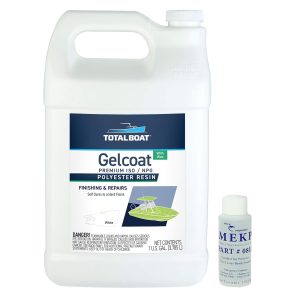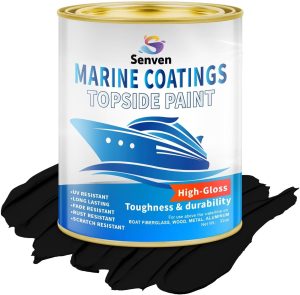Fiberglass is a versatile, lightweight, and durable material commonly used in various industries, from construction and automotive to marine and home decor. Whether you’re working with fiberglass boats, bathtubs, or outdoor furniture, ensuring its long-term durability and aesthetic appeal requires proper maintenance and care. One of the most essential aspects of caring for fiberglass surfaces is choosing the best paint for fiberglass.
We will explore everything you need to know about painting fiberglass, from why it’s important to select the right paint to step-by-step instructions on how to apply it. We’ll also discuss the top paint options for fiberglass and provide helpful tips for ensuring a beautiful, long-lasting finish.
Why Should You Paint Fiberglass?
Fiberglass, while inherently durable, can suffer from fading, discoloration, and wear over time, especially when exposed to harsh environmental conditions. Painting fiberglass is not just about improving its appearance; it also serves to protect the material, increase its lifespan, and ensure it continues to perform optimally. Here are some key reasons to paint fiberglass surfaces:
1. Aesthetic Enhancement
Fiberglass surfaces may not always retain their original luster after prolonged exposure to the sun, water, and other environmental factors. Faded or discolored fiberglass can make boats, bathtubs, and furniture look old and worn out. A fresh coat of paint restores the surface’s shine and vibrancy, giving it a polished and updated appearance.
2. Protection Against Environmental Damage
Fiberglass, like any other material, is vulnerable to environmental elements such as moisture, UV rays, and temperature fluctuations. If left untreated, this exposure can lead to fading, cracking, or even structural damage. Painting fiberglass provides an added layer of protection, helping to safeguard it against further wear and tear.
3. Improved Longevity
A well-applied coat of paint serves as a barrier that protects the fiberglass from dirt, grime, and other contaminants. This increases the material’s resistance to cracking, chipping, and fading, ultimately extending its lifespan and reducing the need for repairs or replacements.
4. Increased Value
For fiberglass boats, vehicles, or even home interiors, painting can increase the resale value. A well-maintained and attractive finish is a strong selling point for buyers, making it a worthwhile investment to ensure your fiberglass surfaces are painted properly.
What Type of Paint Is Best for Fiberglass?
Not all paints are suitable for fiberglass surfaces, as they need to bond well with the smooth, often non-porous surface of the material. When choosing the best paint for fiberglass, you must consider its durability, weather resistance, and flexibility. There are several types of paints to consider, each with unique features and benefits. Here’s a breakdown of the best options for fiberglass:
1. Epoxy Paint

Epoxy paints are the top choice for fiberglass due to their exceptional durability, hardness, and resistance to chemicals and weather elements. This type of paint is often used for fiberglass boats, pools, and even countertops because of its ability to withstand high wear and tear. It is particularly valued for its ability to provide a tough, long-lasting finish.
Benefits:
- Durability: Epoxy forms a hard, thick coating that resists scratches, stains, and abrasions.
- Weather Resistance: It is highly resistant to UV rays, moisture, and temperature fluctuations.
- Chemical Resistance: Epoxy paint can withstand exposure to a variety of chemicals, making it ideal for boats and other outdoor fiberglass surfaces.
Recommended Products:
- Interlux Interprotect 2000E Epoxy Primer: A top-tier epoxy primer that offers superior protection for fiberglass surfaces, especially boats.
- Rust-Oleum Marine Topside Paint: Known for its durability and high-gloss finish, Rust-Oleum’s marine paint is an excellent option for fiberglass boat surfaces.
2. Polyurethane Paint

Polyurethane paint is another excellent choice for fiberglass, offering a glossy finish that is resistant to fading, chipping, and scratching. It is particularly useful for automotive, boat, and industrial fiberglass applications due to its smooth finish and superior protection.
Benefits:
- High Gloss Finish: Polyurethane paint provides a professional, glossy finish that enhances the appearance of fiberglass.
- Scratch and Chip Resistant: It forms a tough, flexible coating that resists scratches, chips, and abrasions.
- UV Resistance: Polyurethane paint is highly resistant to UV rays, ensuring that the color doesn’t fade quickly when exposed to sunlight.
Recommended Products:
- Krylon Fusion All-In-One Spray Paint: This spray paint works well for fiberglass and is highly praised for its ease of use and long-lasting results.
- PPG Industrial Coatings Amercoat Polyurethane: A high-performance polyurethane paint ideal for fiberglass surfaces in industrial settings.
3. Acrylic Paint

Acrylic paints are versatile and water-based, making them easy to apply to fiberglass. While acrylics may not be as durable as epoxy or polyurethane, they are a good option for fiberglass projects that don’t undergo heavy wear, such as home decor or furniture.
Benefits:
- Ease of Application: Acrylic paint is easy to apply and dries quickly, allowing for faster project completion.
- Flexibility: Acrylics are flexible and can expand and contract with the fiberglass, making them a good option for surfaces that experience slight movement.
- Low VOCs: Many acrylic paints are low in volatile organic compounds (VOCs), making them a safer and more eco-friendly option.
Recommended Products:
- Rust-Oleum Universal All Surface Spray Paint: This versatile paint works well on fiberglass and provides a smooth, durable finish.
- Benjamin Moore Regal Select Exterior Acrylic Paint: This premium acrylic paint offers a long-lasting finish and is resistant to fading and mildew.
4. Gel Coat

Gel coat is a resin-based product commonly used for fiberglass boats, pools, and other watercraft. It provides an incredibly smooth, glossy finish that is both visually appealing and protective.
Benefits:
- Durability: Gel coats are highly durable and provide a long-lasting, hard finish that resists chipping and scratches.
- Water Resistance: Gel coats offer superior protection against water and moisture, making them ideal for boats and other watercraft.
- Smooth Finish: The gel coat creates a smooth, glossy surface that looks sleek and polished.
Recommended Products:
- West System 105 Resin and Hardener: This product is used in combination with other materials to create a durable gel coat finish for fiberglass surfaces.
- TotalBoat Gel Coat: A popular gel coat product that provides superior UV protection and durability for fiberglass boats and watercraft.
5. Specialty Marine Paint

For fiberglass boats and other watercraft, specialized marine paint is often required. Marine paints are formulated to withstand harsh saltwater, constant sun exposure, and frequent contact with moisture. These paints often combine epoxy, polyurethane, and other chemicals to offer the ultimate protection.
Recommended Products:
- Interlux Brightside Polyurethane Topside Paint: This highly durable and UV-resistant marine paint is ideal for fiberglass boats and provides a glossy, long-lasting finish.
- Sea Hawk Sharkskin HD Marine Paint: Known for its durability and resistance to harsh marine environments, this paint is perfect for fiberglass boats exposed to saltwater.
How to Paint Fiberglass: Step-by-Step Guide
Now that you know the best paints for fiberglass, let’s go over the steps involved in preparing and painting fiberglass surfaces. Proper preparation is key to achieving a smooth, durable finish.
Step 1: Clean the Fiberglass Surface
Before applying any paint, thoroughly clean the fiberglass surface to remove dirt, grime, grease, and other contaminants. You can use a mild detergent or a specialized fiberglass cleaner to scrub the surface. For boats or outdoor fiberglass, make sure to remove any marine life or algae buildup as well. Rinse the surface with clean water and let it dry completely.
Step 2: Sand the Surface
Fiberglass surfaces tend to be smooth and glossy, which can make it difficult for paint to adhere properly. Sanding the surface with medium-grit sandpaper (around 120-grit) will create tiny grooves for the paint to grip onto. Sand the surface gently to avoid causing damage. If the fiberglass is already painted, make sure to sand off any peeling or chipped paint.
Step 3: Apply a Primer
Priming the fiberglass is essential to ensure good adhesion and coverage. Use a primer specifically designed for fiberglass, such as an epoxy or bonding primer. Apply a thin coat and allow it to dry completely according to the manufacturer’s instructions. This step is especially important if you’re working with a new, unpainted fiberglass surface.
Step 4: Paint the Fiberglass
Once the primer is dry, apply your chosen paint. Whether you’re using epoxy, polyurethane, or acrylic paint, be sure to apply thin, even coats to avoid drips and streaks. You can use a brush, roller, or spray gun for application. Allow each coat to dry before applying the next one. Typically, two to three coats of paint are recommended for optimal coverage.
Step 5: Allow the Paint to Cure
After applying the final coat of paint, allow the surface to cure completely. The curing time will depend on the type of paint used, but generally, you should wait 24 to 48 hours before using the fiberglass surface. Be patient to ensure the best possible finish.
Frequently Asked Questions
1. Can I use regular paint on fiberglass?
Regular paints, such as household paints, are not ideal for fiberglass surfaces. It is best to use specialized paints, such as epoxy, polyurethane, or acrylic, that are designed for smooth and durable finishes on fiberglass.
2. How long does painted fiberglass last?
The lifespan of painted fiberglass depends on the quality of the paint, environmental factors, and how well the surface is maintained. On average, a well-painted fiberglass surface can last anywhere from 3 to 10 years before requiring touch-ups or reapplication.
3. Can I paint fiberglass over gel coat?
Yes, you can paint over a gel coat, but the surface must be properly prepared. Sand the gel coat to ensure the paint adheres, and apply a primer before painting.
4. Do I need to use a primer on fiberglass?
Yes, using a primer is crucial for ensuring good paint adhesion and long-lasting results. A primer designed specifically for fiberglass will create a suitable surface for the paint to bond to.
5. Can I paint fiberglass without sanding it?
While it’s possible to paint fiberglass without sanding, sanding helps improve adhesion and ensures a more durable and smooth finish. Skipping this step may result in poor paint adhesion.
6. Is epoxy or polyurethane better for fiberglass?
Both epoxy and polyurethane are excellent choices for fiberglass, but epoxy tends to offer better durability and chemical resistance, making it ideal for boats and areas that experience high wear. Polyurethane is a good choice for a glossy finish and scratch resistance.
7. How do I clean fiberglass surfaces before painting?
Clean fiberglass surfaces using a mild detergent or fiberglass cleaner. Scrub the surface to remove dirt, grease, and other contaminants, and rinse thoroughly with clean water before allowing it to dry completely.
Conclusion
Choosing the best paint for fiberglass is essential for maintaining its appearance and durability. Epoxy, polyurethane, and acrylic paints all offer unique benefits, so selecting the right one for your specific needs is crucial. By following proper preparation steps and applying the right paint, you can extend the life of your fiberglass surfaces while ensuring they look their best for years to come.


Leave a Reply